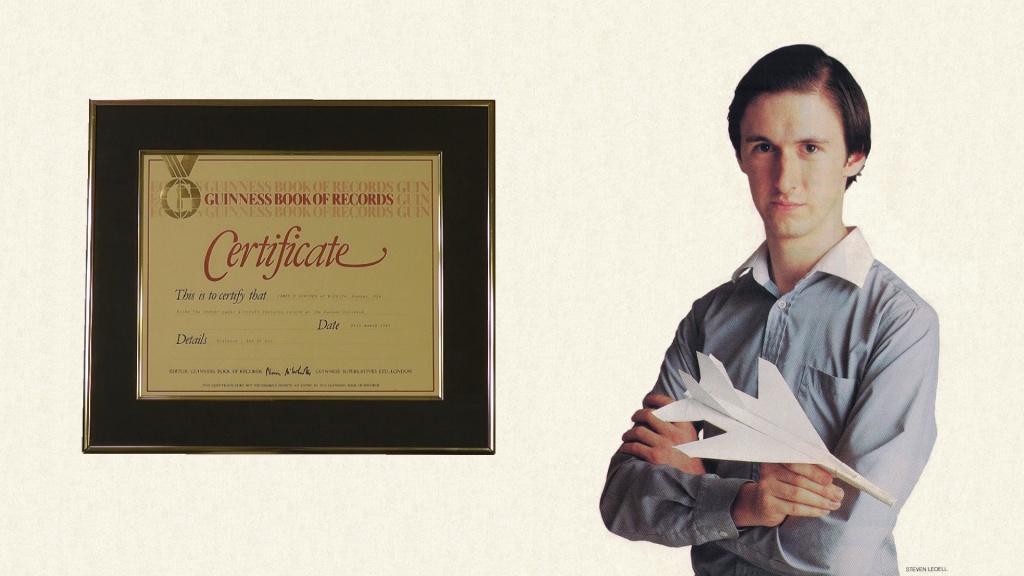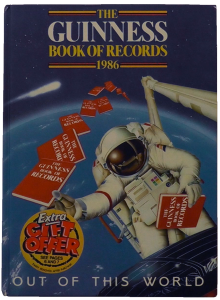Record & Awards

1977-79, 1982-1985 Wichita State University AIAA Paper Airplane Contents: Many prizes for Distance, Aerobatics (3 required stunts scored) and Original Design (1985 was the last year contest was held.)
1985 GUINNESS WORLD RECORD for Distance with a Paper Aircraft: 164'4", March 28-1985. (Appears in the British Hardback Edition with incorrect distance of 166'4", but NOT the US Edition, because it was beaten in May 1985 by Tony Felch.) Prepared to retake record with new design (218'), needed bigger building, then rules changed. (Scroll down for complete story.)
1985 2nd Great International Paper Airplane Contest: 3rd Place Professional Aesthetic Design & Honorable Mention for forward gliding paper autogyro with lifting rotors that spin on paper axles. My work appeared in several publications.
1995 McDonald Douglas Contest (The year it was open to outsiders): Duration, 1st Place Fold & Fly & 2nd place Profile Scale.
2006 Cessna Food Drive Paper Airplane Contest, 1st Place Duration.
2007-2008 Organized & ran Cessna Food Drive Paper Airplane Contest
1977-79, 1982-1985 Wichita State University AIAA Paper Airplane Contents: Many prizes for Distance, Aerobatics (3 required stunts scored) and Original Design (1985 was the last year contest was held.)
Press Coverage
Guinness Record

I set a Guinness World Record for Distance on March 28, 1985, with my X-21Bmk-4. The mk-4 was a scaled up version of my 1976 X-21A fighter, which was a lightweight notebook paper airplane designed to combine tight turns and aerobatics with distance. I built the X-21Bmk-1, 2 and 3 versions in the 1970s, and flew them up to 175' outdoors within 15 feet of the ground against a very slight headwind, verified by dropping bits of grass clippings. Tony Felch set a 140'2" record in August of 1979. I had several airplanes that could easily beat that in the 1970s and early 1980s. I just needed a big room. In 1982, Eugene Sykes set a 155'7" record with a scale model SR-71 that flew low to the ground, and turned a little bit. After finishing college, I arranged space in the Kansas Coliseum. My X-21Bs were old and beat up, so I built a new mk-4 version. It was among about a dozen airplanes I took to the Coliseum for the record. I had NO prior indoor distance practice, and only 2 hours to set up, test airplanes, pick one, practice, brief the Judges and set a record. Hitting a concrete floor and wood and metal seats damaged airplanes that last for years landing in grass. I almost used my X-36, a new, smaller, much lighter better gliding design that would have been perfect if I had more time to get the trim right. I picked my X-21B, despite the fact it was built wrong (too much weight in front) and did not fly as far or well as the worn out mk-3 used to. After a few throws that went bad or wandered off, it landed in the seats on the other side. It would have gone farther if it had space.
Tony Felch beat my record in May 1985 at 193' with a spear dart hurled high with a running start. Alan Adler entry in the 2nd Great International Paper Airplane Contest in May 1985 surpassed Tony's record at 194', but was not awarded a prize because his heavy paper Aerobie "flying ring" was not an "airplane." Strictly speaking, it was an aircraft, but not an airplane, yet to my knowledge, no Guinness paper aircraft record was awarded.
In 1986 I prepared to retake the record with a new design that flew 218' against a very slight headwind, within 8-9 feet of level ground. One flight went 212' within 6' of level or slightly uphill ground from a standing overhand throw (no foot movement!). I needed a bigger building, but it cost too much. Then I met my wife to be, and left paper aviation for a few years. When I got back to record setting, the rules had changed, banning nontraditional and constructed designs, allowing a 10 meter running start, and limiting you to 10 throws.
The new rules favored reliable spear darts over true flying planes that wandered and hit things. The next record was by Stephen Krieger at 207'4" on September 6, 2003, set with the Sorolach spear dart that concentrated more weight in the nose. Video analysis confirms it was essentially a projectile, which has become accepted practice at paper airplane distance events. In 2012, Joe Ayoob threw the Suzanne paper airplane, designed by John Collins (the "Paper Airplane Guy") 226'10", which actually flew the distance. This is a landmark in paper aviation. The reign of the spear dart may be in jeopardy. This would also be would be the first flying record since the mid 1980s, when the Aerobie Flying Ring, X-21B and SR-71 might have qualified as true flight. I say "might" because there is no video evidence to prove it, but circumstantial evidence suggests at least some of them qualify as flight.
These were what I'd call unlimited class aircraft, along with the first distance record of 91'6"' set at the 1st Great International Contest in 1967 by Robert Meuser's entry. Ken's 16.9 second duration record nearly fell to an unlimited class airplane by Tatuo Yoshida that flew 16.06 seconds at the 2nd Great international contest in 1985. I don't have a good throwing arm, but I can fly a good bit farther than I can throw, even when limited to the same weight. If the rules allowed all kinds of construction, even at the same weight, airplanes could fly farther and longer than today's records, particularly if they were made and trimmed by experts and thrown by athletes. Given what I know is possible, over 100 meters (328') could be attained with a true flying hand thrown unlimited class aircraft!
Copyright and Creative Commons Permission Policy
Contact Me
